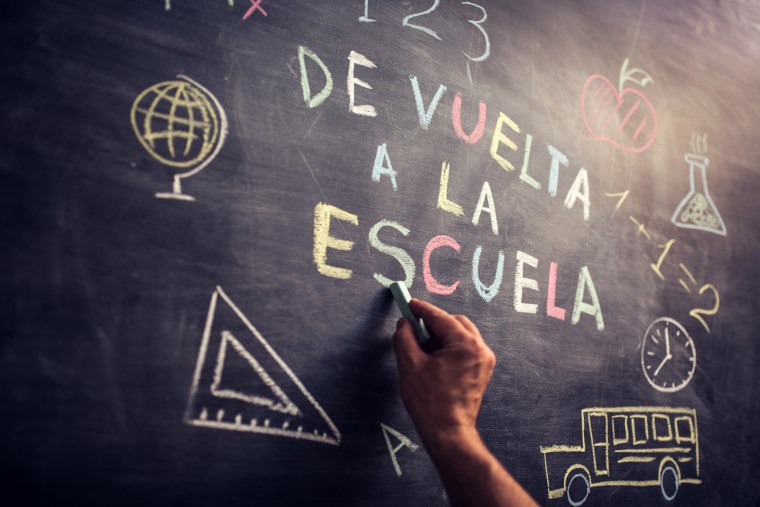New York state is failing to ensure that children and teenagers who come from families who don't speak English as the first language don't fall behind, according to a coalition that advocates for educational opportunities for people of color.
A newly released report from the LEAD coalition, a group of 30 organizations, points out that the state has the nation's second lowest graduation rate among multilingual learners (MLLs) and English Language Learner (ELLs), as well as higher dropout rates and lower rates of proficiency in math and English as compared to the rest of the student population.
In just the last decade, New York's MLL students have grown by almost 20 percent — they now make up 9 percent of the state’s student population. The roughly 237,000 MLL students in New York are mainly concentrated in New York City, Yonkers and upstate cities such as Syracuse.
Even as this student population has quickly grown, the state has lacked in one key area: certified bilingual teachers. "In fact, since 1990, New York state is only one of two states that has had a consistent yearly shortage of certified bilingual teachers. And, in some regions across the state, the percentage of uncertified teachers teaching bilingual students is over 20 percent," the report states. The other state is Texas.
Increasing the number of certified bilingual and English as a second language (ESOL) teachers, as well as adding guidance counselors and after-school resources are especially important factors. A growing proportion of the state’s MLL student community is older than other students at their grade level, leaving them less time to finish high school by the age of 21.
Moreover, older students in later grades who come in with fewer class credits need twice the help in half the time, all while learning two languages. Similarly, teens identified as Students with Limited or Interrupted Formal Education (SLIFE), or those who have either not received necessary early education literacy or who have large gaps in their schooling require additional services to catch up and graduate.
This is the first time in recent years that education leaders from different areas— advocates, schools, nonprofits, government leaders and others — have organized together to push for these changes.
“ELLs continue to be one of the least serviced kids in the city,” Rita Rodríguez, project director at Advocates for Children of NY, said Tuesday during a panel hosted by the Hispanic Federation, one of the nation’s most prominent Latino nonprofits. Both organizations are part of the LEAD Coalition.
Falling behind
Only 13 percent of the state's MLL or ELL students are proficient in math and 5 percent are proficient in English in New York state assessment tests, the report found.
In addition, “the MLL four-year dropout rate in New York state has risen from 23 percent to 30 percent over the last three years, while the dropout rate for all students has decreased from 7 percent to 6 percent over the same period,” it said.
The groups' call to action comes at a time when New York's student population, like in other parts of the country, has become more diverse following increased immigration in the past couple of decades.
“Bilingual education is a right in this state,” Angélica Infante-Green, deputy commissioner at the New York State Education Department, said. “When you walk into a building, it is not up to the building official to decide whether you get a bilingual program or not.”
According to the report, almost 65 percent of MLLs are Latino, followed by Asian or native Hawaiian/other Pacific Islanders at 20 percent.
“It is a MLL crisis. But it is very much a Latino crisis,” Infante-Green said. “We need to call it what it is.”
Data shows how it can be improved
MLL students who start in early grades and go through middle school do see improvement; according to data from the New York State Education Department, MLL students in grades three to eight experienced an increase in English Language Arts (ELA) proficiency of 5.5 percentage points between 2014 and 2017.
Even more encouraging, most students who were previously identified as MLL but then transitioned out of the classification do score at or above proficient in English language and math assessments.
“Our kids outperform everyone. What does that mean?” Infante-Green said. “Our kids are achievers when given the right opportunity.”
The report's authors outlined a series of recommendations, including the formation of a state commission to oversee progress for MLL students, incentivizing teachers to get the necessary certifications to teach bilingual students, and a restoration of education funding that was frozen during the 2009 fiscal crisis and cut during the recession that followed. This funding included efforts targeted at increasing MLL graduation rates and more programs to foster parental participation and awareness.
“Our kids can excel, but the question is: Are we willing to put in the right resources, the right people in and the right support?” said Joe Luft, executive director of Internationals Network, which works with recent immigrant students who are ELLs.
Experts recommended allocating at least $85 million per year to address MLL students' needs.
The money could fund MLL programs and resources, including providing THE students with statewide standardized exams in their home language. In New York, students need to pass these state exams in order to graduate high school with certain credits.
“There’s no reason these kids can’t be assessed in their home language,” Infante-Green said. “We have not been able to do it because we don’t have the funding. That’s the bottom line.”
Democratic state Sen. Robert Jackson, who represents northern and western Manhattan, introduced a bill Monday to form the commission recommended in the report.
“If it doesn’t happen now, I don’t think it would happen ever,” said Evelyn DeJesus, vice president of the Education United Federation of Teachers, a teachers’ union.
FOLLOW NBC LATINO ON FACEBOOK, TWITTER AND INSTAGRAM.



